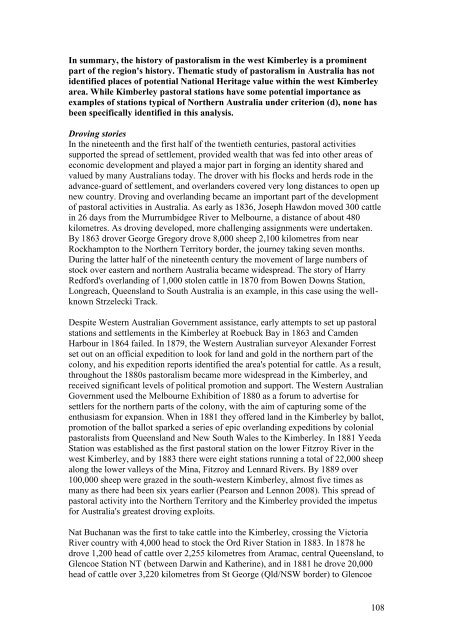WEST KIMBERLEY PLACE REPORT - Department of Sustainability ...
WEST KIMBERLEY PLACE REPORT - Department of Sustainability ...
WEST KIMBERLEY PLACE REPORT - Department of Sustainability ...
Create successful ePaper yourself
Turn your PDF publications into a flip-book with our unique Google optimized e-Paper software.
In summary, the history <strong>of</strong> pastoralism in the west Kimberley is a prominent<br />
part <strong>of</strong> the region's history. Thematic study <strong>of</strong> pastoralism in Australia has not<br />
identified places <strong>of</strong> potential National Heritage value within the west Kimberley<br />
area. While Kimberley pastoral stations have some potential importance as<br />
examples <strong>of</strong> stations typical <strong>of</strong> Northern Australia under criterion (d), none has<br />
been specifically identified in this analysis.<br />
Droving stories<br />
In the nineteenth and the first half <strong>of</strong> the twentieth centuries, pastoral activities<br />
supported the spread <strong>of</strong> settlement, provided wealth that was fed into other areas <strong>of</strong><br />
economic development and played a major part in forging an identity shared and<br />
valued by many Australians today. The drover with his flocks and herds rode in the<br />
advance-guard <strong>of</strong> settlement, and overlanders covered very long distances to open up<br />
new country. Droving and overlanding became an important part <strong>of</strong> the development<br />
<strong>of</strong> pastoral activities in Australia. As early as 1836, Joseph Hawdon moved 300 cattle<br />
in 26 days from the Murrumbidgee River to Melbourne, a distance <strong>of</strong> about 480<br />
kilometres. As droving developed, more challenging assignments were undertaken.<br />
By 1863 drover George Gregory drove 8,000 sheep 2,100 kilometres from near<br />
Rockhampton to the Northern Territory border, the journey taking seven months.<br />
During the latter half <strong>of</strong> the nineteenth century the movement <strong>of</strong> large numbers <strong>of</strong><br />
stock over eastern and northern Australia became widespread. The story <strong>of</strong> Harry<br />
Redford's overlanding <strong>of</strong> 1,000 stolen cattle in 1870 from Bowen Downs Station,<br />
Longreach, Queensland to South Australia is an example, in this case using the wellknown<br />
Strzelecki Track.<br />
Despite Western Australian Government assistance, early attempts to set up pastoral<br />
stations and settlements in the Kimberley at Roebuck Bay in 1863 and Camden<br />
Harbour in 1864 failed. In 1879, the Western Australian surveyor Alexander Forrest<br />
set out on an <strong>of</strong>ficial expedition to look for land and gold in the northern part <strong>of</strong> the<br />
colony, and his expedition reports identified the area's potential for cattle. As a result,<br />
throughout the 1880s pastoralism became more widespread in the Kimberley, and<br />
received significant levels <strong>of</strong> political promotion and support. The Western Australian<br />
Government used the Melbourne Exhibition <strong>of</strong> 1880 as a forum to advertise for<br />
settlers for the northern parts <strong>of</strong> the colony, with the aim <strong>of</strong> capturing some <strong>of</strong> the<br />
enthusiasm for expansion. When in 1881 they <strong>of</strong>fered land in the Kimberley by ballot,<br />
promotion <strong>of</strong> the ballot sparked a series <strong>of</strong> epic overlanding expeditions by colonial<br />
pastoralists from Queensland and New South Wales to the Kimberley. In 1881 Yeeda<br />
Station was established as the first pastoral station on the lower Fitzroy River in the<br />
west Kimberley, and by 1883 there were eight stations running a total <strong>of</strong> 22,000 sheep<br />
along the lower valleys <strong>of</strong> the Mina, Fitzroy and Lennard Rivers. By 1889 over<br />
100,000 sheep were grazed in the south-western Kimberley, almost five times as<br />
many as there had been six years earlier (Pearson and Lennon 2008). This spread <strong>of</strong><br />
pastoral activity into the Northern Territory and the Kimberley provided the impetus<br />
for Australia's greatest droving exploits.<br />
Nat Buchanan was the first to take cattle into the Kimberley, crossing the Victoria<br />
River country with 4,000 head to stock the Ord River Station in 1883. In 1878 he<br />
drove 1,200 head <strong>of</strong> cattle over 2,255 kilometres from Aramac, central Queensland, to<br />
Glencoe Station NT (between Darwin and Katherine), and in 1881 he drove 20,000<br />
head <strong>of</strong> cattle over 3,220 kilometres from St George (Qld/NSW border) to Glencoe<br />
108
















